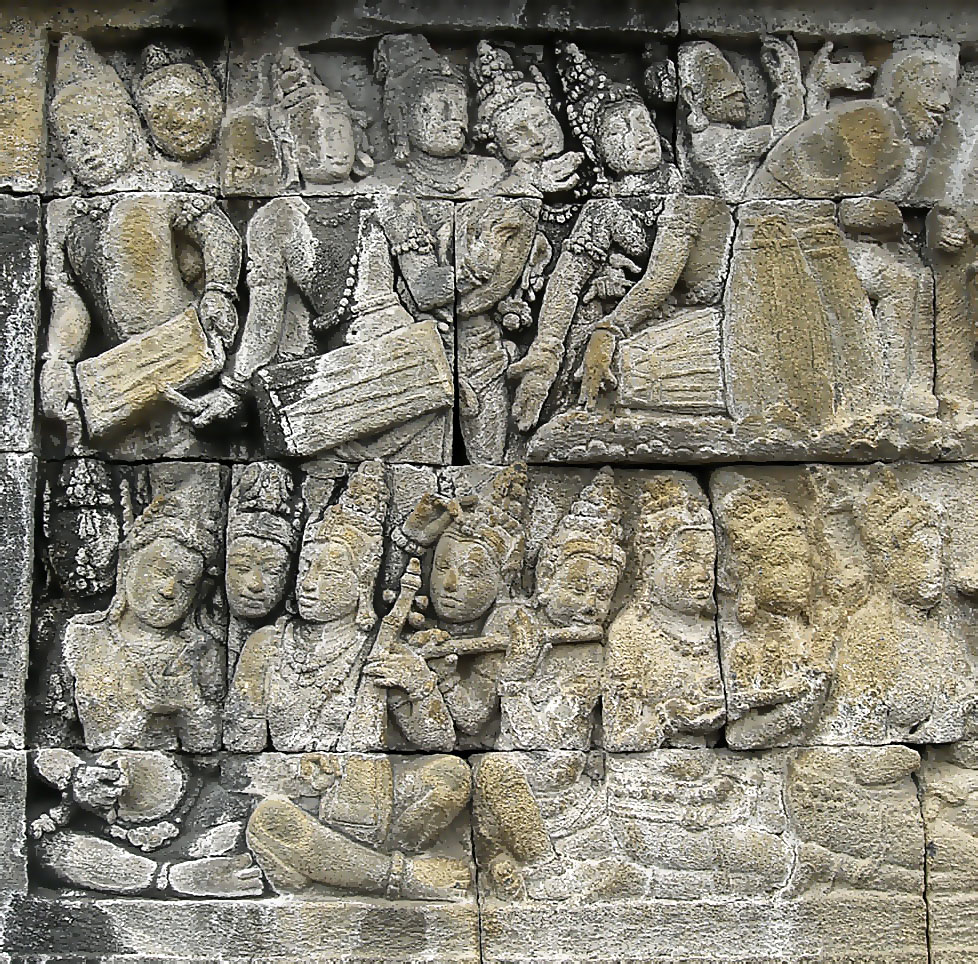|
Le Marteau Sans Maître
''Le Marteau sans maître'' (; The Hammer without a Master) is a chamber cantata by French composer Pierre Boulez. The work, which received its premiere in 1955, sets surrealist poetry by René Char for contralto and six instrumentalists. It is among his most acclaimed compositions. History Before ''Le Marteau'', Boulez had established a reputation as the composer of Modernism (music), modernist and Serialism, serialist works such as ''Structures (Boulez), Structures I'', ''Polyphonie X'', as well as his infamously "unplayable" Piano sonatas (Boulez), Second Piano Sonata. ''Le Marteau'' was first written as a six-movement composition between 1953 and 1954, and was published in that form in the latter year, "imprimée pour le Donaueschingen Festival, festival de musique, 1954, Donaueschingen" (though in the end it was not performed there) in a photographic reproduction of the composer's manuscript by Universal Edition, given the catalog number UE 12362. In 1955 Boulez revised ... [...More Info...] [...Related Items...] OR: [Wikipedia] [Google] [Baidu] |
Pierre Boulez
Pierre Louis Joseph Boulez (; 26 March 19255 January 2016) was a French composer, conductor and writer, and the founder of several musical institutions. He was one of the dominant figures of post-war contemporary classical music. Born in Montbrison, Loire, Montbrison, in the Loire department of France, the son of an engineer, Boulez studied at the Conservatoire de Paris with Olivier Messiaen, and privately with Andrée Vaurabourg and René Leibowitz. He began his professional career in the late 1940s as music director of the Renaud-Barrault theatre company in Paris. He was a leading figure in avant-garde music, playing an important role in the development of integral serialism in the 1950s, Aleatoric music, controlled chance music in the 1960s and the electronic transformation of instrumental music in real time from the 1970s onwards. His tendency to revise earlier compositions meant that his body of work was relatively small, but it included pieces considered landmarks of twent ... [...More Info...] [...Related Items...] OR: [Wikipedia] [Google] [Baidu] |
Xylorimba
The xylorimba (sometimes referred to as xylo-marimba or marimba-xylophone) is a pitched percussion instrument similar to an extended-range xylophone with a range identical to some 5-octave celestas or 5-octave marimbas, though typically an octave higher than the latter. Despite its name, it is not a combination of a xylophone and a marimba; its name has been a source of confusion, as many composers have called for a 'xylorimba', including Alban Berg, Pierre Boulez and Olivier Messiaen, but for parts requiring only a four-octave xylophone. However, Pierre Boulez wrote for two five-octave xylorimbas in . Like the xylophone and marimba, the xylorimba consists of a series of wooden bars laid out like a piano keyboard "with a compass sufficiently large to embrace the low-sounding bars of the marimba and the highest-sounding bars of the xylophone." The lower notes of the xylorimba are described as sounding closer to a xylophone than a marimba, on account of its bars being both thicker ... [...More Info...] [...Related Items...] OR: [Wikipedia] [Google] [Baidu] |
Second Viennese School
The Second Viennese School () was the group of composers that comprised Arnold Schoenberg and his pupils, particularly Alban Berg and Anton Webern, and close associates in early 20th-century Vienna. Their music was initially characterized by late- Romantic expanded tonality and later, a totally chromatic expressionism without a firm tonal centre, often referred to as atonality; and later still, Schoenberg's serial twelve-tone technique. Twelve tone Composition was revolutionized by Arnold Schoenberg. Using this technique when composing he made sure he used all 12 notes in a chromatic scale when forming a melody, this would be called the "Primeseries". This series would later be enhanced in his compositions through permutations such as, Retrogrades, Inversions, Transformations etc. How this happens is, Schoenberg taking the pitches of the Primeseries and through his "Magic Square" of permutations takes said pitches and depending on which permutation he is utilizing, creates a new s ... [...More Info...] [...Related Items...] OR: [Wikipedia] [Google] [Baidu] |
Sprechstimme
(, "spoken singing") and (, "spoken voice"), more commonly known as speak-singing in English, are expressionist musical vocal techniques between singing and speaking. Though sometimes used interchangeably, is directly related to the operatic recitative manner of singing (in which pitches are sung, but the articulation is rapid and loose like speech), whereas is closer to speech itself (because it does not emphasise any particular pitches). is more closely aligned with the long-used musical techniques of recitative or than is . Where the term is employed in this way, it is usually in the context of the late Romantic German operas or "music dramas" that were composed by Richard Wagner and others in the 19th century. Thus, is often merely a German alternative to 'recitative'. The earliest compositional use of the technique was in the first version of Engelbert Humperdinck's 1897 melodrama '' Königskinder'' (in the 1910 version it was replaced by conventional singin ... [...More Info...] [...Related Items...] OR: [Wikipedia] [Google] [Baidu] |
Glissando
In music, a glissando (; plural: ''glissandi'', abbreviated ''gliss.'') is a wikt:glide, glide from one pitch (music), pitch to another (). It is an Italianized Musical terminology, musical term derived from the French ''glisser'', "to glide". In some contexts, it is equivalent to portamento, which is a continuous, seamless glide between notes. In other contexts, it refers to discrete, stepped glides across notes, such as on a piano. Some terms that are similar or equivalent in some contexts are slide, sweep bend, smear, rip (for a loud, violent glissando to the beginning of a note), lip (in jazz terminology, when executed by changing one's embouchure on a wind instrument), plop, or falling hail (a glissando on a harp using the back of the fingernails). On wind instruments, a scoop is a glissando ascending to the onset of a note achieved entirely with the embouchure, except on instruments that have a slide (such as a trombone). Notation The glissando is indicated by following the ... [...More Info...] [...Related Items...] OR: [Wikipedia] [Google] [Baidu] |
Incises
''Incises'' (1994/2001) and ''Sur Incises'' (1996/1998) are two related works of the French composer Pierre Boulez. The pitches of the row used in ''Incises'' and ''Sur Incises'' are based on the Sacher hexachord, the same as those used in the rows for '' Répons'', '' Messagesquisse'', and '' Dérive 1''. ''Incises'' ''Incises'' ("Interpolations") for solo piano was composed in 1994 as a test piece for the Umberto Micheli Piano Competition, where it was first performed on 21 October 1994. Boulez revised it in 2001. ''Incises'' was Boulez's first work for solo piano since his Third Piano Sonata of 1955–57/63. The piece lasts less than ten minutes. The work plays with contrasts of gestures and textures, for instance, repeated pitches or chords in an even tempo interrupted by violent melodic arcs, or sparse chordal interjections without discernible rhythm over long held sonorities. Reviewing a 2005 performance of ''Incises'', Tim Page described the work thus: "''Incises'' ... [...More Info...] [...Related Items...] OR: [Wikipedia] [Google] [Baidu] |
Koto (musical Instrument)
The is a Japanese plucked half-tube zither instrument, and the national instrument of Japan. It is derived from the Chinese and , and similar to the Mongolian , the Korean and , the Vietnamese , the Sundanese and the Kazakh . Koto are roughly in length, and made from Paulownia wood ('' Paulownia tomentosa'', known as ). The most common type uses 13 strings strung over movable bridges used for tuning, different pieces possibly requiring different tuning. Seventeen-string koto are also common, and act as bass in ensembles. Koto strings are generally plucked using three fingerpicks (), worn on the first three fingers of the right hand. Names and types The character for ''koto'' is , although is often used. However, (''koto'') is the general term for all string instruments in the Japanese language,(jaKotobank koto/ref> including instruments such as the , , , , , and so on. When read as , it indicates the Chinese instrument . The term is used today in the same way. Th ... [...More Info...] [...Related Items...] OR: [Wikipedia] [Google] [Baidu] |
Music Of Japan
In Japan, music includes a wide array of distinct genres, both traditional and modern.ref> The word for "music" in Japanese is 音楽 (''ongaku''), combining the kanji 音 ''on'' (sound) with the kanji 楽 ''gaku'' (music, comfort). Japan is the world's largest market for music on physical media and the second-largest overall music market, with a retail value of US$2.7 billion in 2017. Traditional and folk music Gagaku, hougaku The oldest forms of traditional Japanese music are: * , or Buddhist chanting * , or orchestral court music both of which date to the Nara (710–794) and Heian (794–1185) periods. Gagaku classical music has been performed at the Imperial court since the Heian period. Kagura-uta (神楽歌), Azuma-asobi (東遊) and Yamato-uta (大和歌) are indigenous repertories. Tōgaku (唐楽) allegedly resembles a Chinese Tang dynasty (618–907) style; komagaku may have come from the Korean Peninsula. In addition, gagaku subdivides into kangen (管弦) ... [...More Info...] [...Related Items...] OR: [Wikipedia] [Google] [Baidu] |
Guitar
The guitar is a stringed musical instrument that is usually fretted (with Fretless guitar, some exceptions) and typically has six or Twelve-string guitar, twelve strings. It is usually held flat against the player's body and played by strumming or Plucked string instrument, plucking the strings with the dominant hand, while simultaneously pressing selected strings against frets with the fingers of the opposite hand. A guitar pick may also be used to strike the strings. The sound of the guitar is projected either Acoustics, acoustically, by means of a resonant hollow chamber on the guitar, or Amplified music, amplified by an electronic Pickup (music technology), pickup and an guitar amplifier, amplifier. The guitar is classified as a chordophone, meaning the sound is produced by a vibrating string stretched between two fixed points. Historically, a guitar was constructed from wood, with its strings made of catgut. Steel guitar strings were introduced near the end of the nineteen ... [...More Info...] [...Related Items...] OR: [Wikipedia] [Google] [Baidu] |
Gamelan
Gamelan (; ; , ; ) is the traditional musical ensemble, ensemble music of the Javanese people, Javanese, Sundanese people, Sundanese, and Balinese people, Balinese peoples of Indonesia, made up predominantly of percussion instrument, percussive instruments. The most common instruments used are metallophones (played with mallets) and a set of hand-drums called ''kendang'', which keep the beat (music), beat. The ''kemanak'', a banana-shaped idiophone, and the ''gangsa'', another metallophone, are also commonly used gamelan Musical instrument, instruments on Bali. Other notable instruments include xylophones, bamboo flutes (similar to the Indian ''bansuri''), a bowed string instrument called a ''rebab'' (somewhat similar to the ''gadulka'' of Bulgaria), and a zither-like instrument called a ''siter'', used in Javanese gamelan. Additionally, vocalists may be featured, being referred to as ''sindhen'' for females or ''gerong'' for males.Sumarsam (1998)''Introduction to Javanese ... [...More Info...] [...Related Items...] OR: [Wikipedia] [Google] [Baidu] |
Music Of Bali
The Music of Bali, Bali is an Indonesian island that shares in the gamelan and other Indonesian musical styles. Bali, however, has its own techniques and styles, including kecak, a form of singing that imitates the sound of monkeys. In addition, the island is home to several unique kinds of gamelan, including the gamelan jegog, gamelan gong gede, gamelan gambang, gamelan selunding and gamelan semar pegulingan, the cremation music angklung and the processional music bebonangan. Modern popular styles include gamelan gong kebyar, dance music which developed during the Dutch occupation and 1950s era joged bumbung, another popular dance style. In Balinese music you can also hear metallophones, gongs and xylophones. Characteristics Balinese music can be compared to Javanese music, especially that of the pre-Islamic period. During that time, Javanese tonal systems were imported to Bali. Balinese gamelan, a form of Indonesian classical music, is louder, swifter and m ... [...More Info...] [...Related Items...] OR: [Wikipedia] [Google] [Baidu] |






